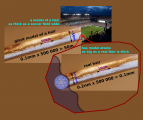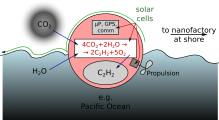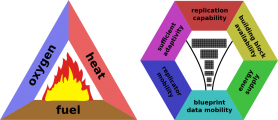Difference between revisions of "Mechadense's Wiki about Atomically Precise Manufacturing"
m (→Videos: removed accidental insertion) |
(→What this site is for?: significant rewrite) |
||
| Line 29: | Line 29: | ||
= What this site is for? = | = What this site is for? = | ||
| − | + | The aims of this wiki are: | |
| − | + | ||
| − | + | * '''To gather information specifically relevant for the development of a personal fabricator.''' | |
| − | + | * To collect relevant TODO points. | |
| + | * To show that we already know which questions have to be investigated. | ||
| + | * To show that by now there is enough knowledge for targeted development instead of aimless research. | ||
| + | * To show that it's already rather clear what we have to do next. | ||
| + | * To show that there is a lack of people working toward that goal today. | ||
| + | * To convey an [[intuitive feel]] for the mechanics of stiff AP structures. | ||
| + | * To explain the different aspects of the still far off but [[exploratory engineering|somewhat predictable]] advanced AP systems. | ||
| + | * To clarify that the different aspects of advanced AP systems have a sound basis and are potentially of high value. | ||
| + | * To discuss near and far [[dangers]] and [[opportunities]]. | ||
| + | * To gather [[general discussion]]s about APM related topics like e.g. about [[general software issues]]. | ||
| + | * To present this huge amount of fairly uncirculated knowledge in a for it suitable way. That is ... | ||
| + | * To gather all this information in a nonlinear hyperlinked fashion. | ||
| + | * To be comprehensible by average technological interested people but not at the expese of inaccuracy. | ||
---- | ---- | ||
| − | Today (2014) there is a puzzle of technological fragments. There are fragments of todays technology as well as fragments of future technology. Those fragments of future technology are to a certain degree credible since they are quite well accessible for theoretical investigation. The objective is to find and locate all the ends of the fragments that are located at the beginning of the time-line and to find out what work needs to be done to tie them together with the beginning of the fragments later in the time-line. | + | Today (2014,2015) there is a puzzle of technological fragments. There are fragments of todays technology as well as fragments of future technology. Those fragments of future technology are to a certain degree credible since they are quite well accessible for [[exploratory engineering|theoretical investigation]]. The objective is to find and locate all the ends of the fragments that are located at the beginning of the time-line and to find out what work needs to be done to tie them together with the beginning of the fragments later in the time-line. |
| − | + | == Contributing == | |
| − | + | '''If you want an account please contact the site admin. You can find the contact information on the about page.''' <br> | |
| − | + | '''Please read the guidelines on the [[community portal]] before contributing.''' <br> | |
| − | + | '''Note:''' When contributing here please '''avoid''' using the term '''nanotechnology''' and use more precise and specific terms ([[APM related terms|APM related terms]]) instead.<br> | |
| − | + | [[History]] has led to the fact that "nanotechnology" now (2013..2015) almost exclusively links to '''non''' atomically precise technologies or products of SciFi fantasy. The term "nanotechnology" is as specific as the term "makrotechnology" that is rarely used because of its generality. | |
| − | + | ||
= Why do we need APM? = | = Why do we need APM? = | ||
Revision as of 21:59, 11 March 2015
| Language: en | Sprache: de |
 A personal desktop gem-gum factory fabblet with dynamically deployed protective hood. |
The personal gem gum factory is:
The personal gem gum factory makes:
|
The existence of a personal fabricator will have profound impact on global human society. The basis for such a personal fabricator - the atomically precise manufacturing (APM) technology - is beginning to be figured out today.
|
- Freshy created content of this site can be found here: "site activity of the last 60 days"
- Link to the overview over all pages of this site: Special:AllPages.
Contents
What is atomically precise manufacturing (APM)
General APM
Advanced APM
Advanced Atomically precise manufacturing (APM) is a prospective method of production for material goods of all sizes.
The products of this manufacturing method consist out of atomically precise parts. These constituent parts like e.g. bearings gears springs and housing structures have the smallest possible physical size that allows for their functioning. When assembled the systems they create strikingly resemble conventional factory-equipment that one finds at the meter scale but on the meter scale those new kind of clearly non biological products may well be designed to be smooth elastic and seamless a trait only biological matter illustrates today. In contrast to atomic scale biological systems those artificial atomically precise systems do not rely on thermal movement for their function, instead they operate in the machine phase. Out of various reasons silicon, diamond and similar substances are suitable building materials. All of the parts have their surfaces chemically plugged (passivated). Passivated surfaces do not bind to one another (not covalently to be exact). When they are aligned such that their atomic roughness can't intermesh they slide on each other wear free and superlubricating.
With exploratory engineering it was shown [1] that AP products of the targeted type will perform better than most products out of materials known today and due to the decentral (at home / locally) and direct (raw material to product in one step) characteristics of the manufacturing process there is also reason to assume that AP products will be cheap in production. Combined those properties may lead to drastic changes in human civilization over a short period of time giving us an opportunity to rapidly solve yet untacklable global problems but also presenting us to new kinds of dangers.
The technical details about the targeted kind of technology can be found in the book Nanosystems [1]. It contains details about math physics and chemistry behind those machines. Among other things there is explained why quantum uncertainty is not really a problem, why thermal movement is a solvable challenge and why knowledge about natural solution phase chemistry is not directly applicable to chemical synthesis in the machine phase (mechanosynthesis).
What this site is for?
The aims of this wiki are:
- To gather information specifically relevant for the development of a personal fabricator.
- To collect relevant TODO points.
- To show that we already know which questions have to be investigated.
- To show that by now there is enough knowledge for targeted development instead of aimless research.
- To show that it's already rather clear what we have to do next.
- To show that there is a lack of people working toward that goal today.
- To convey an intuitive feel for the mechanics of stiff AP structures.
- To explain the different aspects of the still far off but somewhat predictable advanced AP systems.
- To clarify that the different aspects of advanced AP systems have a sound basis and are potentially of high value.
- To discuss near and far dangers and opportunities.
- To gather general discussions about APM related topics like e.g. about general software issues.
- To present this huge amount of fairly uncirculated knowledge in a for it suitable way. That is ...
- To gather all this information in a nonlinear hyperlinked fashion.
- To be comprehensible by average technological interested people but not at the expese of inaccuracy.
Today (2014,2015) there is a puzzle of technological fragments. There are fragments of todays technology as well as fragments of future technology. Those fragments of future technology are to a certain degree credible since they are quite well accessible for theoretical investigation. The objective is to find and locate all the ends of the fragments that are located at the beginning of the time-line and to find out what work needs to be done to tie them together with the beginning of the fragments later in the time-line.
Contributing
If you want an account please contact the site admin. You can find the contact information on the about page.
Please read the guidelines on the community portal before contributing.
Note: When contributing here please avoid using the term nanotechnology and use more precise and specific terms (APM related terms) instead.
History has led to the fact that "nanotechnology" now (2013..2015) almost exclusively links to non atomically precise technologies or products of SciFi fantasy. The term "nanotechnology" is as specific as the term "makrotechnology" that is rarely used because of its generality.
Why do we need APM?
The prospective products of AP technology are a chance to solve the global problems of human civilization and to preserve and further enrich our world. Further there are some essays about why you should care. Nonetheless public interest is declining (number of searches; newsgroup activity). Also in wide parts of the world APM is as good as unknow to the general public.
The reason for that development could be:
- The rapid increase of non atomically precise nanotechnology was drawing all attention away. See history.
- A lack of a place where the importance of AP Technology is explained, exciting but not so near motivational examples are given and at the same time grounded technical aspects are shown. (This site here could be such a place.)
How do we build a personal fabricator?
| Technology levels of the incremental path | |
|---|---|
| Level 0 | side products |
| Level I | side products |
| Level II | side products |
| Level III | pre-products products maybe |
There are two approaches:
- the direct path
- the incremental path
There is a some discussion about the perception of APM related work due to the people promoting the direct path - see: pathway controversy. This dates back to a dispute over the "ownership" over the very generic word "nanotechnology". This dispute led to a temporarily loss of publicly perceived credibility & funding of anything related to APM - see: history. Further the term atomically precise manufacturing way introduced by Eric Drexler to have a more specific name for the technology described on this wiki.
How long will it take us to get there? One may assume that:
- It will take too long to lean back and say "we don't need to solve environmental problems because AP Technology will solve them.
- It will come too fast to lean back and say "we don't need to think about effects of the dangers that the arising APM technology will bring.
The speed of progress in microcomputer technology shows that system complexity isn't so much of a hurdle. Finding the right steps through the initial path puts the greatest question-mark on the time-spans to expect. There's no such thing as a Moores law yet that we could track. Its not even sure if such a law may even occur and which metric would be used. Taking a completely arbitrary shot in the blue I'd say (the site admin) from now (2014) it will take somewhere between one and four generations (4G's ~ one long lifetime).
External links
Locally hosted files
- Slides from the talk the apm-wiki site admin gave at the austrian "linuxwochen" event: slides-pdf-file
Webpages
- Foresight Institute: Nanotechnology
- Disquisition 2013 "Nano-solutions for the 21st century: Unleashing the fourth technological revolution"
- Zyvex's definition of APM
Videos
- Nanotechnologist Chris Phoenix on Molecular Manufacturing (2014-09?)
- Video of oxford talk (2014): Eric K. Drexler speaks about his new book "Radical Abundance"
- John Randall: "Atomically Precise Manufacturing" at Foresight Technical Conference 2013
Illuminating Atomic Precision: Foresight Technical Conference January 2013 - Fully Printed (2010-06) - Note: Diamondoid nanofactories will look and work differently and won't produce food.
- Ralph Merkle - An introduction to Molecular Nanotechnology (2009-11)
- presentation by Phillip Moriarty (2009-09):
SENS4 - Molecular Nanotechnology in the Real World: How Feasible is a Nanofactory?
(1/4) - (2/4) - (3/4) - (4/4) - Nottingham Nanotechnology debate (2005-08-24):
(1/7) - (2/7) - (3/7) - (4/7) - (5/7) - (6/7) - (7/7)
- BBC Horizon Nanoutopia (1995) - Note: The term "nanotechnology" turned out to be to unspecific and the assembler concept is now superseded by the nanofactory concept. The complexity of a nanofactory will be akin to modern day computer chips.




